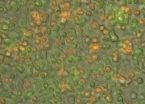(Press-News.org) The next time you feel a sneeze coming on, raise your elbow to cover up that multiphase turbulent buoyant cloud you're about to expel.
That's right: A novel study by MIT researchers shows that coughs and sneezes have associated gas clouds that keep their potentially infectious droplets aloft over much greater distances than previously realized.
"When you cough or sneeze, you see the droplets, or feel them if someone sneezes on you," says John Bush, a professor of applied mathematics at MIT, and co-author of a new paper on the subject. "But you don't see the cloud, the invisible gas phase. The influence of this gas cloud is to extend the range of the individual droplets, particularly the small ones."
Indeed, the study finds, the smaller droplets that emerge in a cough or sneeze may travel five to 200 times further than they would if those droplets simply moved as groups of unconnected particles � which is what previous estimates had assumed. The tendency of these droplets to stay airborne, resuspended by gas clouds, means that ventilation systems may be more prone to transmitting potentially infectious particles than had been suspected.
With this in mind, architects and engineers may want to re-examine the design of workplaces and hospitals, or air circulation on airplanes, to reduce the chances of airborne pathogens being transmitted among people.
"You can have ventilation contamination in a much more direct way than we would have expected originally," says Lydia Bourouiba, an assistant professor in MIT's Department of Civil and Environmental Engineering, and another co-author of the study.
The paper, "Violent expiratory events: on coughing and sneezing," was published in the Journal of Fluid Mechanics. It is co-written by Bourouiba, Bush, and Eline Dehandschoewercker, a graduate student at ESPCI ParisTech, a French technical university, who previously was a visiting summer student at MIT, supported by the MIT-France program.
Smaller drops, longer distances
The researchers used high-speed imaging of coughs and sneezes, as well as laboratory simulations and mathematical modeling, to produce a new analysis of coughs and sneezes from a fluid-mechanics perspective. Their conclusions upend some prior thinking on the subject. For instance: Researchers had previously assumed that larger mucus droplets fly farther than smaller ones, because they have more momentum, classically defined as mass times velocity.
That would be true if the trajectory of each droplet were unconnected to those around it. But close observations show this is not the case; the interactions of the droplets with the gas cloud make all the difference in their trajectories. Indeed, the cough or sneeze resembles, say, a puff emerging from a smokestack.
"If you ignored the presence of the gas cloud, your first guess would be that larger drops go farther than the smaller ones, and travel at most a couple of meters," Bush says. "But by elucidating the dynamics of the gas cloud, we have shown that there's a circulation within the cloud � the smaller drops can be swept around and resuspended by the eddies within a cloud, and so settle more slowly. Basically, small drops can be carried a great distance by this gas cloud while the larger drops fall out. So you have a reversal in the dependence of range on size."
Specifically, the study finds that droplets 100 micrometers � or millionths of a meter � in diameter travel five times farther than previously estimated, while droplets 10 micrometers in diameter travel 200 times farther. Droplets less than 50 micrometers in size can frequently remain airborne long enough to reach ceiling ventilation units.
A cough or sneeze is a "multiphase turbulent buoyant cloud," as the researchers term it in the paper, because the cloud mixes with surrounding air before its payload of liquid droplets falls out, evaporates into solid residues, or both.
"The cloud entrains ambient air into it and continues to grow and mix," Bourouiba says. "But as the cloud grows, it slows down, and so is less able to suspend the droplets within it. You thus cannot model this as isolated droplets moving ballistically."
Ready for a close-up
The MIT researchers are now developing additional tools and studies to extend our knowledge of the subject. For instance, given air conditions in any setting, researchers can better estimate the reach of a given expelled pathogen.
"An important feature to characterize is the pathogen footprint," Bush says. "Where does the pathogen actually go? The answer has changed dramatically as a result of our revised physical picture."
Bourouiba's continuing research focuses on the fluid dynamics of fragmentation, or fluid breakup, which governs the formation of the pathogen-bearing droplets responsible for indoor transmission of respiratory and other infectious diseases. Her aim is to better understand the mechanisms underlying the epidemic patterns that occur in populations.
"We're trying to rationalize the droplet size distribution resulting from the fluid breakup in the respiratory tract and exit of the mouth," she says. "That requires zooming in close to see precisely how these droplets are formed and ejected."
INFORMATION:
Written by Peter Dizikes, MIT News Office
Funding for the study was provided by the National Science Foundation.
How coughs and sneezes float farther than you think
Novel study uncovers the way coughs and sneezes stay airborne for long distances
2014-04-08
ELSE PRESS RELEASES FROM THIS DATE:
Gothenburg scientist in Nature: Climate models underestimate costs to future generations
2014-04-08
The seven scientists behind the article, due to be published 10 April, conclude that the reports by the UN climate panel serve an important function in setting the agenda for climate research. Yet the most important role of the Intergovernmental Panel on Climate Change (IPCC) is to inform the global political discussion on how the harm caused by climate change should be handled.
Thomas Sterner, expert on policy instruments to reduce greenhouse gas emissions, is a Coordinating Lead Author of one key chapter on policy instruments in the Working Group III of the Fifth Assessment ...
Are women in Iran who use Facebook less likely to wear a veil?
2014-04-08
New Rochelle, NY, April 8, 2014—Use of social media such as Facebook can influence attitudes and behaviors among people of all countries and cultures. Among women in Iran, the duration and amount of daily Facebook activity is associated with their desire to wear a traditional head-covering and their willingness to display pictures of themselves without a veil, according to an article in Cyberpsychology, Behavior, and Social Networking, a peer-reviewed journal from Mary Ann Liebert, Inc., publishers. The article is available free on the Cyberpsychology, Behavior, and Social ...
New research may provide effective nonsurgical treatment for knee osteoarthritis
2014-04-08
New Rochelle, NY, April 8, 2014—A new nonsurgical approach to treating chronic pain and stiffness associated with knee osteoarthritis has demonstrated significant, lasting improvement in knee pain, function, and stiffness. This safe, two-solution treatment delivered in a series of injections into and around the knee joint is called prolotherapy, and is described in The Journal of Alternative and Complementary Medicine, a peer-reviewed journal from Mary Ann Liebert, Inc., publishers. The article is available free on The Journal of Alternative and Complementary Medicine website.
David ...
Breast cancer cell subpopulation cooperation can spur tumor growth
2014-04-08
Subpopulations of breast cancer cells sometimes cooperate to aid tumor growth, according to Penn State College of Medicine researchers, who believe that understanding the relationship between cancer subpopulations could lead to new targets for cancer treatment.
Cancers contain genetically different subpopulations of cells, called subclones. Researchers have long known that these mutant subclones aggressively compete with one another to become the dominant tumor cell population. However, in some cases it seems that no single subclone can achieve dominance on its own. ...
Tracking sugar movement in plants
2014-04-08
A new study published in the Proceedings of the National Academy of Sciences by scientists at the University of Queensland, Australia, overturns a long-held theory in plant science [see:http://www.bnl.gov/newsroom/news.php?a=11631]. Researchers at the U.S. Department of Energy's (DOE) Brookhaven National Laboratory who are co-authors on this paper conducted critical radiotracer studies that support the new theory that plant sugars play a dominant role in regulating branching at plant stems. While branching has relevance in agriculture, it is also very important in bioenergy ...
Dartmouth researchers identify potential therapeutic target for deadly brain cancer
2014-04-08
(Lebanon, NH, 4/8/14) Researchers from the Geisel School of Medicine at Dartmouth will present a scientific poster on Tuesday, April 8, 2014 at the American Association of Cancer Researchers conference in San Diego, CA. The research identifies a potential characteristic for predicting outcome in a deadly form of brain cancer known as glioblastoma multiforme.
Existing therapies based on genetic information have failed to effectively treat glioblastomas. Therefore, researchers are aggressively looking to find new molecular targets for this aggressive brain tumor.
Dartmouth ...
Novel plant biotechnology approach for sustainable production of pharmaceutical compounds
2014-04-08
European scientists have made ground-breaking discoveries for improving the efficiency of the production of pharmaceuticals through plant biotechnology. Biotechnological production offers a cost-effective and environmentally friendly alternative to the chemical synthesis of rare and complex pharmaceutical compounds currently isolated from plants. The results have been achieved in the European SmartCell project coordinated by VTT Technical Research Centre of Finland.
Several expensive anticancer alkaloid blockbusters used in chemotherapy, such as terpenoid indole alkaloids ...
New breast cancer results illustrate promise and potential of I-SPY 2 trial
2014-04-08
In an innovative clinical trial led by UC San Francisco, the experimental drug neratinib along with standard chemotherapy was found to be a beneficial treatment for some women with newly diagnosed, high-risk breast cancer.
Additionally, researchers learned that an algorithm used in the adaptive, randomized trial known as I-SPY 2 was highly effective at predicting the success of the treatment regimen in the patients who have HER2-positive/HR-negative disease.
The finding marks the second drug "graduation" within the I-SPY 2 trial model, which is designed to accelerate ...
Geography research could improve the effectiveness of hospital patient transport services
2014-04-08
University of Cincinnati research is offering hospitals and trauma centers a unique, accurate and scientific approach to making decisions about transporting critical-care patients by air or by ambulance. A presentation this week at the annual meeting of the Association of American Geographers (AAG) in Tampa, Fla., highlights the research of Michael Widener, a UC assistant professor of geography, along with Zac Ginsberg, MD, Maryland Shock Trauma Center; Samuel Galvagno Jr., assistant professor, Divisions of Trauma Anesthesiology and Adult Critical Care Medicine, Maryland ...
Grandmas stay sharp when they care for grandkids once a week
2014-04-08
CLEVELAND, Ohio (April 8, 2014)—Taking care of grandkids one day a week helps keep grandmothers mentally sharp, finds a study from the Women's Healthy Aging Project study in Australia, published online today in Menopause, the journal of The North American Menopause Society (NAMS). That's good news for women after menopause, when women need to lower their risks of developing Alzheimer's disease and other cognitive disorders.
On the other hand, taking care of grandchildren five days a week or more had some negative effects on tests of mental sharpness. "We know that older ...
LAST 30 PRESS RELEASES:
Interaction of climate change and human activity and its impact on plant diversity in Qinghai-Tibet plateau
From addressing uncertainty to national strategy: an interpretation of Professor Lim Siong Guan’s views
Clinical trials on AI language model use in digestive healthcare
Scientists improve robotic visual–inertial trajectory localization accuracy using cross-modal interaction and selection techniques
Correlation between cancer cachexia and immune-related adverse events in HCC
Human adipose tissue: a new source for functional organoids
Metro lines double as freight highways during off-peak hours, Beijing study shows
Biomedical functions and applications of nanomaterials in tumor diagnosis and treatment: perspectives from ophthalmic oncology
3D imaging unveils how passivation improves perovskite solar cell performance
Enriching framework Al sites in 8-membered rings of Cu-SSZ-39 zeolite to enhance low-temperature ammonia selective catalytic reduction performance
AI-powered RNA drug development: a new frontier in therapeutics
Decoupling the HOR enhancement on PtRu: Dynamically matching interfacial water to reaction coordinates
Sulfur isn’t poisonous when it synergistically acts with phosphine in olefins hydroformylation
URI researchers uncover molecular mechanisms behind speciation in corals
Chitin based carbon aerogel offers a cleaner way to store thermal energy
Tracing hidden sources of nitrate pollution in rapidly changing rural urban landscapes
Viruses on plastic pollution may quietly accelerate the spread of antibiotic resistance
Three UH Rainbow Babies & Children’s faculty elected to prestigious American Pediatric Society
Tunnel resilience models unveiled to aid post-earthquake recovery
Satellite communication systems: the future of 5G/6G connectivity
Space computing power networks: a new frontier for satellite technologies
Experiments advance potential of protein that makes hydrogen sulfide as a therapeutic target for Alzheimer’s disease
Examining private equity’s role in fertility care
Current Molecular Pharmacology achieves a landmark: real-time CiteScore advances to 7.2
Skeletal muscle epigenetic clocks developed using postmortem tissue from an Asian population
Estimating unemployment rates with social media data
Climate policies can backfire by eroding “green” values, study finds
Too much screen time too soon? A*STAR study links infant screen exposure to brain changes and teen anxiety
Global psychiatry mourns Professor Dan Stein, visionary who transformed mental health science across Africa and beyond
KIST develops eco-friendly palladium recovery technology to safeguard resource security
[Press-News.org] How coughs and sneezes float farther than you thinkNovel study uncovers the way coughs and sneezes stay airborne for long distances




